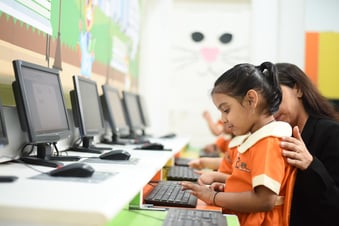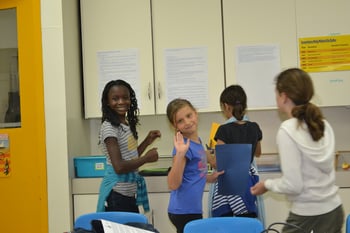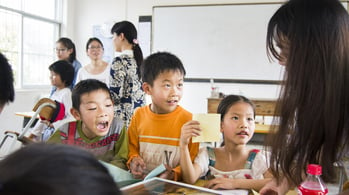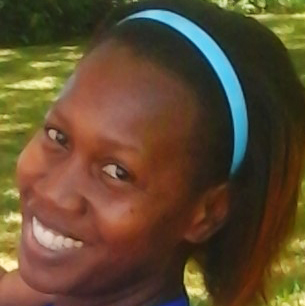.jpg?width=770&name=180919_KS-Shot-2_03-final%20%20(16x9).jpg)
Collaboration, Communication, Creativity, and Critical Thinking
One of the main aims of the education system is preparing students to fill jobs in the workforce. That workforce has evolved greatly in the last few decades with the advent of the Digital Age. It has become much more technology-driven with a high demand for workers in fields related to Science, Technology, Engineering, and Mathematics (STEM). Furthermore, all indications from the US Bureau of Labor Statistics are for continued rapid growth in the type and number of STEM-related jobs across various industries. In fact, the rate of employment growth in STEM occupations was double that of non-STEM fields between 2009-2015, and the trends don’t show signs of slowing.
Educators have taken note of this trend and its implications for the teaching-learning process. In 2002, the National Education Association (NEA), the United States Department of Education, and several high-ranking companies in the information and technology sector spearheaded the formation of the Partnership for 21st Century Skills (P21), a national advocacy organization that encourages the use of technology in education and provides tools and resources to support it.
Over the years, P21 has refined the list of desirable skills for the STEM-enabled workforce into what is now known as the 4 Cs: Collaboration, Communication, Creativity, and Critical Thinking. These skills work in tandem with the knowledge-based and technical skills children are taught, in order to foster deeper learning in all content areas.
The 4 Cs are Soft Skills
Knowledge-based and technical skills are also referred to as hard skills; they're the ones we traditionally teach and test in schools. The other set of skills, which includes the 4 Cs, is known as soft skills. They encompass a long and varied list of vital life skills, including many facets of a person’s emotional and social intelligence.
Despite being called “soft,” these skills are just as important for students to master as the hard skills. In fact, Dr. Laura A. Jana, Associate Research Professor at Penn State University, takes issue with the use of the term “soft” for these essential skills. She points out that the name “doesn’t do them justice.” It belies their significant role in student-development and the increased focus which has been placed on them as part of P21.
A Closer Look at Each of the 4 Cs
The 4 Cs are actually personality traits which students will need in order to be successful in the new job market. At first, they may seem like vague, unteachable concepts, which might explain why in the past, they were mainly found among the skills, values, and attitudes transmitted solely via the hidden curriculum, or informal lessons, skills, and values students develop throughout their time in school. The 4 Cs, however, can be taught and they can be tested—just as we do with hard skills. They simply require a different, more student-centered approach to our teaching.
Critical Thinking
 Critical thinking is often paired with problem solving. It engages kids in higher order thought processes which they apply to information they are presented with, as well as to the evaluation of any conclusions they make from that information. It involves the students’ ability to analyze, interpret, reason through, and synthesize information.
Critical thinking is often paired with problem solving. It engages kids in higher order thought processes which they apply to information they are presented with, as well as to the evaluation of any conclusions they make from that information. It involves the students’ ability to analyze, interpret, reason through, and synthesize information.
Children show improved decision-making ability and problem-solving skills when they have well-developed critical thinking skills. They're better able to not only come up with solutions but to compare and test possible solutions to select the one best suited to the current problem and the situation in which it is framed.
Critical thinking often gets singled out as the most important of the 4 Cs. Many educators are quick to point out, however, that children will only be able to master critical thinking, or any of the other Cs, when they practice using them together.
Building Critical Thinking in The Classroom
You can help children to hone their critical thinking skills by presenting them with problem situations which are linked to content in the curriculum and, preferably, integrate different subject areas. It's also possible for children to come up with the problem situations on their own, based on their experiences with and observations of real-world issues.
Students can then engage in activity-based tasks for finding, testing, and evaluating plausible solutions. You, in the role of facilitator, can encourage students to follow through with each of the steps and evaluate the entire process once they're complete.
Creativity
Creativity is the ability to be innovative, inventive, and think outside the box. It's also about more than creating new concrete objects or machines. It includes the ability to generate new ideas and design new processes, as well as redesign old ones. It's coming up with unique ways to solve problems or improve existing systems.
Much like critical thinking, creativity has become one of the buzzwords in education, and in particular in STEM education. The good news is that children are naturally creative. And, as Sir Ken Robinson shared in his 2006 TED Talk, it’s our job as educators to make sure we don’t inadvertently teach that creativity out of them. We need, instead, to provide opportunities for them to practice their creative skills.
When we allow kids to be creative and let their ideas flow, it encourages them to:
When we allow kids to be creative and let their ideas flow, it encourages them to:
- Experiment with a variety of materials and options.
- Be persistent.
- Embrace trial and error.
- Share their creativity with others in productive ways.
- See value in what others create.
Building Creativity in The Classroom
Creativity is very personal, so it's important that you as their teacher promote a spirit of acceptance in the classroom. You can do this by ensuring that while one child is sharing their ideas, everyone else is paying attention and prepared to give constructive feedback.
You can also turn the classroom into a creative space and model your own creativity and innovative thinking in the teaching methodology you use. Flexible classroom layouts, color, and visual aids are just a few options for steeping a classroom in creativity. Modeling may also involve talking through the processes you use to come up with ideas and to modify them where necessary. You can also make use of opportunities to incorporate creative activities such as brainstorming, free-writing, and riddles in your lessons.
Collaboration
The skill of collaboration is the skill of teamwork. Kids must learn to function productively as a member of a group, regardless of:
- Their Specific Role – Students may be called upon to assume different roles within the group, but they must learn to work effectively with others no matter their defined responsibilities.
- Group Objectives – Individual students may have preferred different objectives from those being pursued by the group. As part of the group, however, they should be fully on board with its efforts and show a willingness to compromise and to make constructive inputs.
- The Group’s Size – Students should actively engage with others in the group and contribute meaningfully to it whether they are working in pairs, in small groups, or as an entire class.
Building Collaboration in The Classroom
 When we ask students to achieve a common goal, we're helping to develop their collaborative skills. We can go a step further as we stand on the sidelines, by encouraging students to speak up and voice their opinions when there are decisions to be made.
When we ask students to achieve a common goal, we're helping to develop their collaborative skills. We can go a step further as we stand on the sidelines, by encouraging students to speak up and voice their opinions when there are decisions to be made.
Of course, we must also ensure that students are guided in how to listen objectively and be constructive in their comments, especially when they are not in agreement. That way, students feel it is alright to share what they are thinking even though others may have different views.
Communication
The skill of Communication actually refers to effective communication: the ability to explain your ideas or convey your opinion in a clear and concise manner. It also entails the ability to make judgement calls on the validity and relevance of sources of information that you come across.
Other aspects of effective communication include students’ ability to:
- Gauge the reactions of others as they present their ideas and modify their delivery accordingly.
- Listen actively while others are communicating with them in order to accurately interpret the message being conveyed.
- Bring across their ideas orally, in writing, or by use of other media, such as graphs, diagrams, and images.
- Select the best means of communication (written, verbal, visual, etc.) for the information they wish to share.
Building Communication in The Classroom

Helping students to grow in their ability to communicate effectively means we should give them sufficient opportunities to practice. Those opportunities must involve the student as both the presenter and receiver of information. It's a good idea to present students with a wide variety of topics and settings as the basis of their communication.
While the topics can naturally flow from the standards in the curriculum, some of the opportunities for practicing communication that teachers can consider are:
- Students making presentations to each other in class.
- Students as an interactive audience to an invited expert on a particular topic.
- Students preparing questions to ask of presenters on a field trip.
- Students acting as expert presenters, perhaps to other members of the school or wider community, as they share information they have gathered while working on a particular topic.
- Students sending letters of requests or suggestions to school officials, community leaders, or members of the business community.
The 4 Cs aren't specific to any one area of the curriculum. Instead, they're meant to complement the facts, theories, and concrete skills that children learn in each of the different subject areas at school. When properly incorporated into effective STEM education for kids, the 4 Cs help to produce multifaceted, well-rounded individuals who are able to thrive in the real world and contribute positively to it.
.png?width=1270&height=453&name=Copy%20of%20Kid%20Spark%20Logo%20(Horizontal%20-%20Full%20Color).png)
